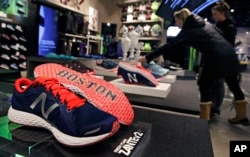Now, from VOA Learning English, this is Words and Their Stories.
American English, like all languages, has countless colorful words and expressions. We call some slang. It is not always easy to explain the history of slang expressions. Some seem to develop out of nowhere. Some do not last very long or become dated very quickly.
Other expressions, however, live on for years. We use them in our day-to-day lives, usually without knowing how they began. Today we look at one such word -- and one you may be wearing right now -- sneakers!
Sneakers are a type of comfortable shoe. We wear them for sports and when we have to walk a lot. Many children wear them to school. And some adults wear them to work, especially if they must walk to work or ride a bike.
Some say that the word “sneaker” is slang for a tennis shoe. Others say it comes from the old English verb “sneak,” meaning to move silently and with speed. If you sneak up on someone and you are wearing sneakers they probably will not hear you. Well, unless your sneakers squeak. We all know squeaky sneakers stop silent sneaking. (Say that five times fast!)
For many people, sneakers are not just for comfort -- they are also fashionable. These people choose the colors and styles very carefully to make a statement about their own personal style. And they may pay a lot of money for them!
So, sneakers can be more than a fashion statement. They can also be a sign of wealth. Some schools in the U.S. even have rules about what sneakers students can and cannot wear. This prevents students from wearing extremely costly sneakers and avoids “sneaker shaming.” This is when you make fun of someone because they are wearing less costly sneakers.
To some people, sneakers are a form of art. In fact, there is a museum in the American city of Boston just for sneakers! The Sneaker Museum celebrates the history of the sneaker and their cultural importance as works of art.
But there are other words for these types of shoes. There are running shoes, cross-trainers and trainers. All of these fit under the same term: athletic shoes.
Sometimes we just call our sneakers by their brand names -- our Chuck T’s, Nikes or Adidas.
If you have an old pair of shoes that you always wear you might call them your beaters.
Now, sneakers may not be your choice of shoe. But you must admit that they are comfortable to wear. Well, if they fit correctly, that is.
Maybe that is why we say, “If the shoe fits … wear it!”
Actually, no. That is not why we say this. We use this expression in a very strange way. Here is what it means.
If someone says something bad about you but it is true -- you have to accept it. You cannot deny it!
For example, a friend of yours is always late for everything. One day, he shows up to your apartment (late, of course) and says, “Can you believe it!? My boss just fired me! She says I am always late!”
You could simply answer, “Well, if the shoe fits…”
You do not even need to finish. Your friend will know exactly what you mean. He is always late and now must take responsibility. He must “wear the shoes” of a person who is always late, so to speak.
But do not be surprised if he leaves your apartment and never talks to you again. The expression “If the shoe fits, wear it” is somewhat rude. So, it is not exactly a nice thing to say, especially if someone has just lost their job!
Now, there is nothing stopping you from using this expression for good behavior…well, except for the fact that I personally have only ever heard it used for bad.
Put your sneakers on
Put your sneakers on,
We're goin' dancin' all night long...
And that’s the end of this Words and Their Stories.
I’m Anna Matteo.
See, I've put my sneakers on
'Cause I'm gonna keep dancin'
After they all go home …
Anna Matteo wrote this story for VOA Learning English. Herb Sutcliff wrote about the (possible) history of the word “sneaker.” Ashley Thompson was the editor. At the end of the show, Vanessa Hudgens sings “Sneakernight.”
_______________________________________________________________
Words in This Story
comfortable – adj. not causing any physically unpleasant feelings : producing physical comfort
squeak – v. to make a short, high-pitched cry or noise
fashionable – adj. following the current fashion or style
shame – v. to force (someone) to act in a specified way by causing feelings of shame or guilt
athletic – adj. of or relating to sports, games, or exercises
rude – adj. not having or showing concern or respect for the rights and feelings of other people : not polite











